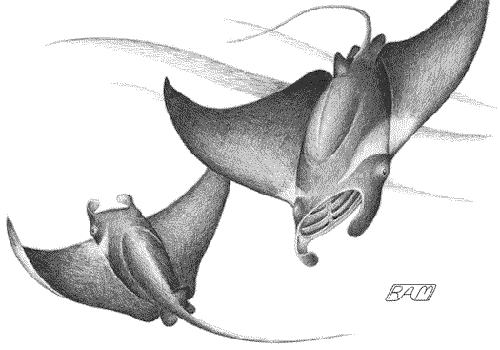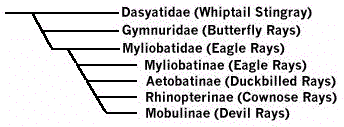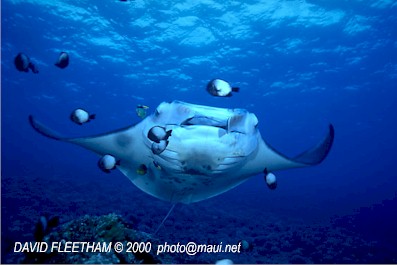Biology of the Manta Ray
(Manta birostris)

An inquiry came across SHARK-L asking "I am in search of any information that can be provide on the biology of the Manta Ray". I responded by forwarding information I had compiled on the species.
| Recognition | A gigantic devilray with gracefully sculpted, falcate pectoral 'wings', paddle-like cephalic lobes projecting forward from the front of the head (actually extensions of the pectoral fins, supported by radial cartilages), and a very broad, rectangular mouth at the end of the head (a mouth type known as 'terminal'), pebble-like teeth in the lower jaw but not the upper. |
| Color | Variable, ranging from black, greyish blue, to greenish or reddish brown above (black color morph sometimes with whitish, triangular shoulder patches), and nearly black, white with various degrees of greyish blotching (the precise pattern of blotching has been used to identify individuals), to almost pure white below; one albino specimen has been reported. |
| Size | Disc width at birth about 4 feet (1.2 metres); maximum disc width 22 feet (6.7 metres), possibly larger (reported to widths of up to 30 feet or 9.1 metres), maximum recorded weight 3 100 pounds (1 400 kilograms). |
| Distribution | Circumtropical (around the globe, generally between 35 degrees north and south latitude), including: off southeastern South Africa, Madagascar, Mozambique, Tanzania, Kenya, and Somalia; in the Gulf of Aden, Red Sea, Arabian Sea, and the Bay of Bengal, off Burma (Myanmar), Thailand, Malaysia, Indonesia, northern Australia, New Guinea, Solomon Islands, Philippines, Kampuchia, Viet Nam, China, Korea, and southern Japan; off Guam, Palau, Yap, New Caledonia, Fiji, and Hawaii; off southern California to northern Peru, North Carolina to southern Brazil, the Azores, Senegal to Liberia. |
| Habitat | Occurs most often in nearshore waters (mainly over continental and insular shelves, but occasionally over deep water), near coral and rocky reefs; swim by flapping their large pectoral fins and are usually encountered near the surface or mid-waters of lagoons or seaward reefs, particularly near surge channels; in Australian waters, Mantas sometimes migrate into temperate waters; they are capable of rapid speed and juveniles sometimes leap well clear of the water, landing with a loud slap (adults drive their bodies only partway out of the water and then fall back into the sea, sometimes performing 2 or 3 of these jumps in succession); often host to one or more discfishes (especially the White Remora, Remorina albescens) and sometimes observed in association with dolphins, seabirds, sharks, and other rays (notably the Spotted Eagle Ray, Aetobatus narinari); these rays actively seek the services of cleaner wrasses (Labroides spp.), often hanging over or swimming near "cleaning stations", sometimes several lining up to wait their turn. |
| Feeding | A gigantic filter-feeder, preying on planktonic crustaceans and small schooling bony fishes; filtering mechanism consists of transverse plates of pinkish-brown spongy tissue that bridge the gaps between successive gill bars (cartilaginous skeletal elements that support the gills); when feeding, the cephalic lobes are unfurled and spread (directing and sometimes apparently scooping plankton-bearing water into the mouth), the animal often swimming in slow somersaults (vertical loops) that are repeated over and over (this behavior may keep the rays within a patch of particularly rich feeding, and may also concentrate planktonic prey to facilitate feeding); most often encountered as solitary individuals, but members of this species often aggregate in regions offering predictably rich feeding (such as off the Kona Surf Hotel at night and off Yap, in the western Caroline Islands) — with up to 50 individuals clustered in the same general area, but not forming true schools. |
| Reproduction | Ovoviviparous, with each of the pups wrapped in a thin-shell that hatches inside the mother, later to be born alive; one specimen harpooned off North Carolina expelled a pup (with one pectoral fin wrapped above its body, and the other wrapped below) in mid-trajectory when it leaped, a behavior which may represent spontaneous abortion (ejected prematurely due to capture stress) or be part of normal birthing (If so, what a dramatic way to enter the world!); litter size 1 to 2 (usually 2) pups, with birthing apparently occur in relatively shallow water, where the young remain for several years before expanding their range farther offshore; mating behavior in this species has recently (July 1997) been filmed off the Ogasawara Islands, Japan, and featured one or more males rapidly chasing a female for 20—30 minutes, after which one male nips the tip of either of the female's pectoral fins (which severely impairs her swimming), moves to her ventral surface, and inserts one of his claspers (paired intromittant organs, developed along the inner margins of the pelvic fins) into her cloaca (vent), thereby mating belly-to-belly; the male may hold onto the (much larger) female's pectoral fin for several minutes after removing his clasper, eventually letting her go free. |
| Age & Growth | Growth of newborns is apparently very rapid, virtually doubling the disc width at birth during the first year of life; males may mature at a disc width of about 13—15 feet (4.0—4.5 metres), females at a disc width of about 16—18 feet (5.0—5.5 metres), but this needs confirmation; no data on age at maturity for either sex. |
| Danger to Humans | Minimal unless attacked (especially harpooned) or otherwise startled, but the enormous size and power of this ray should invite respect. |
| Utilization | Formerly hunted commercially by harpoon from small boats off eastern Australia and in the Sea of Cortez (Gulf of California), this species is now rarely hunted; places where these rays can be reliably encountered (off the Kona coast of Hawaii and off Yap, to name two of the better-known locations), have spawned substantial dive-tourism industries; seemingly inquisitive, individual Mantas sometimes approach and even solicit attention from divers, apparently enjoying the tactile stimulation provided by human contact (as well as the bubbles from scuba exhaust); in areas frequented by divers, however, Mantas often become very wary of divers and cease to approach them. When approached or grasped rapidly, some individuals roll onto their backs (perhaps to keep the offending diver in sight?), sound (dive), and swim away rapidly, righting themselves only when some distance away; another behavioral response to approach by a diver from the side is curving one pectoral fin toward its back and the other toward its belly — forming an S-shape in cross-section — tilting its dorsal (top) surface toward the diver (possibly a defensive response?); in areas where divers often touch Mantas, the rays often develop pinkish skin lesions that may persist for months (apparently these lesions occur where human touch has removed the protective mucus that coats the rays' skin). When diving or snorkeling with these magnificent, supremely graceful rays, resist the temptation to touch them and avoid obstructing their looping glide path while they feed. |
| Remarks | The Manta Ray is one of the very largest and least-known elasmobranchs; although stingless, Manta Rays are actually very closely related to stingrays (family Dasyatidae), the Manta Ray, together with 9 species of devil rays (genus Mobula) comprising a subfamily (Myliobatinae) within that group; until recently, a number of Manta species were considered valid (Manta alfredi, M. ehrenbergi, M. hamiltoni), but all are now tentatively regarded as a single, world-wide species; this matter is currently under investigation by comparison of genetic samples from several populations, which should (hopefully) settle the matter once and for all. |
NOTE: although most of the above information was sifted from the scientific literature on Mantas (what little of it there is), I would like to acknowledge and thank Keller and Wendy Laros of "Manta Pacific", Kona, Hawaii, for several exciting discussions about Manta Ray biology and behavior, which — although I didn't realize it at the time — eventually stimulated this synopsis.
I hope this helps.
Cheers,
— R. Aidan Martin
The pelagic Manta Ray (Manta birostris) sometimes seeks out 'cleaning stations' on coral reefs, where tiny wrasses and other fishes pick parasites from its skin.
Photo © David Fleetham david@davidfleetham.com; used with the gracious permission of the photographer.
A couple hours later, I appended my posting.
After hours of mucking about on my recently-posted synopsis of information on the biology of Manta Rays (Manta birostris), and at long last seeing the light at the end of the proverbial tunnel — indicating that I was nearly finished self-editing and could send off the bloody thing — I inadvertently let an error slip past:
According to the most recently published (1996) batoid systematic hypothesis of John McEachran, Manta and Mobula compose the subfamily Mobulinae, within the family MYLIOBATIDAE, not DASYATIDAE (as I had sloppily stated); however, the dasyatid stingrays are quite closely related to the myliobatid eagle rays:

My sincere apologies for any confusion or inconvenience my error may have caused; I really was trying to be helpful.
With taxonomic egg on my cyber face, I remain
— R. Aidan Martin
Giles Cuny then wrote: Shigeru Shirai (1996, Phylogenetic interrelationships of neoselachians (Chondrichthyes: Neoselachii), In "Interrelationships of fishes, M.L. STIASSNY, L.R. PARENTI & G.D. JOHNSON (eds.), Academic Press, 9-34) seems to support your interpretation, although he refers to the family name as Myliobatididae (and not Myliobatidae, I wonder why) and includes Rhinoptera in the subfamily Mobulinae (Hence there is no subfamily Rhinopterinae left). I responded:
I am familiar with that paper and — while it proposes many systematic ideas that are quite compelling — on matters of batoid systematics and taxonomy, I have opted to more closely follow McEachran et al. 1996 "Interrelationships of the Batoid Fishes" [op. cit., pp 63-84] and Lovejoy 1996, "Systematics of myliobatoid elasmobranchs: with emphasis on the phylogeny and historical biogeography of neotropical freshwater stingrays (Potamotrygonidae: Rajiformes) [Zool.J.Linnaean Soc., 117: 207-257].
Shirai 1996 basically follows Nishida 1990, "Phylogeny of the suborder Myliobatoidei" [Mem.Fac.Fish., Hokkaido Univ., 37: 1-108] in lumping all batoids in the single order Rajiformes and his arrangement of taxa within that order. While regarding all batoids within a single order appeals to my basic bias toward the smallest number of higher level taxa that adequately reflects a given group's morphological diversity and appears to be consistent with the fossil record (an arena in which I am not expert), it seems in this case safer to follow batoid specialists McEachran et al. in regarding the batoids as spanning several orders on par with tiburoid (shark) orders as well as retaining the basic multi-order batoid scheme proposed by Compagno (1973, 1977, 1990, etc.) that has been widely used and stable for over 25 years. As for Shirai's use of 'Myliobatididae' in place of the more traditional 'Myliobatidae', I suspect that he is correct on grounds of the structure of Latin grammar and fine points of nomenclatural form advocated by the International Code of Zoological Nomenclature, but these are areas in which I am also not expert, and have provisionally opted to go with the more traditional spelling for the time being.
McEachran et al. 1996 lump the subfamilies Dasyatinae, Gymnurinae, and Myliobatinae (including the genera Aetobatus, Aetomylaeus, Myliobatis, Pteromylaeus, Rhinoptera, Mobula and Manta) under the single family Dasyatidae. However, Compagno (1973) and Compagno et al. 1989 recognize the families Dasyatidae, Gymnuridae, Myliobatidae, Rhinopteridae, and Mobulidae, while Last & Stevens 1994 recognize the families Myliobatidae, Rhinopteridae, and Mobulidae. Since following a systematic scheme that retains Rhinoptera in its own subfamily, Rhinopterinae, and Shirai's Aetobatinae (which appeals to me as an interesting and provocative way to group Aetobatus, Aetomylaeus and Pteromylaeus) are in no way inconsistent with McEachran et al.'s cladogram (p 78), I have provisionally settled on the following arrangement of taxa:
- Family Dasyatidae — Diamond Stingrays: 51 species
- Family Gymnuridae — Butterfly Rays: 9 species
- Family Myliobatidae — Eagle Rays: 40 species
- Subfamily Myliobatinae — Eagle Rays: 11 species
- Genus Myliobatis: 11 species
- Subfamily Aetobatinae — Duckbilled Rays: 11 species
- Genus Aetobatus: 2 species
- Genus Aetomylaeus: 6 species
- Genus Pteromylaeus: 3 species
- Subfamily Rhinopterinae — Cownose Rays: 8 species
- Genus Rhinoptera: 8 species
- Subfamily Mobulinae — Devil Rays: 10 species
- Genus Mobula: 9 species
- Genus Manta: 1 species
- Subfamily Myliobatinae — Eagle Rays: 11 species
Thus, where I differ from Shirai 1996 and McEachran et al. 1996 is really a matter of where one arbitrarily draws lines demarcating groups and subgroups, giving each group or subgroup a name consistent in form with its position within the overall nested structure of batoid taxa. Since all taxa above the species level are fundamentally arbitrary, having no 'reality' in the natural world, and the logistical demands that my forthcoming elasmobranch biology book be released before the systematic hypotheses of Shirai and McEachran et al. can be properly evaluated by other systematists (a process that will probably take decades of work applying several systematic approaches before some manner of consensus is reached), this small arrogance on my part seems justifiable in the interests of smoothing the transition from Compagno's established systematic scheme and the newer, tentative, and yet-to-be-established systematic ideas of Shirai and McEachran et al. The proposed taxonomic schemes of these workers will no doubt spur much research and be highly influential in decades to come, but advances in cladistic methodology and the application of molecular genetics render it unlikely that either scheme will be the final word on batoid systematics.
I hope this clarifies my position, at least enough to discourage taking the proposed batoid taxonomies of Shirai and McEachran et al. as 'gospel' just yet.
Cheers,
— R. Aidan Martin
Posted to SHARK-L Dec 14 & 15, 1998
For more on this marvelous animal, see the Manta Ray FAQ

